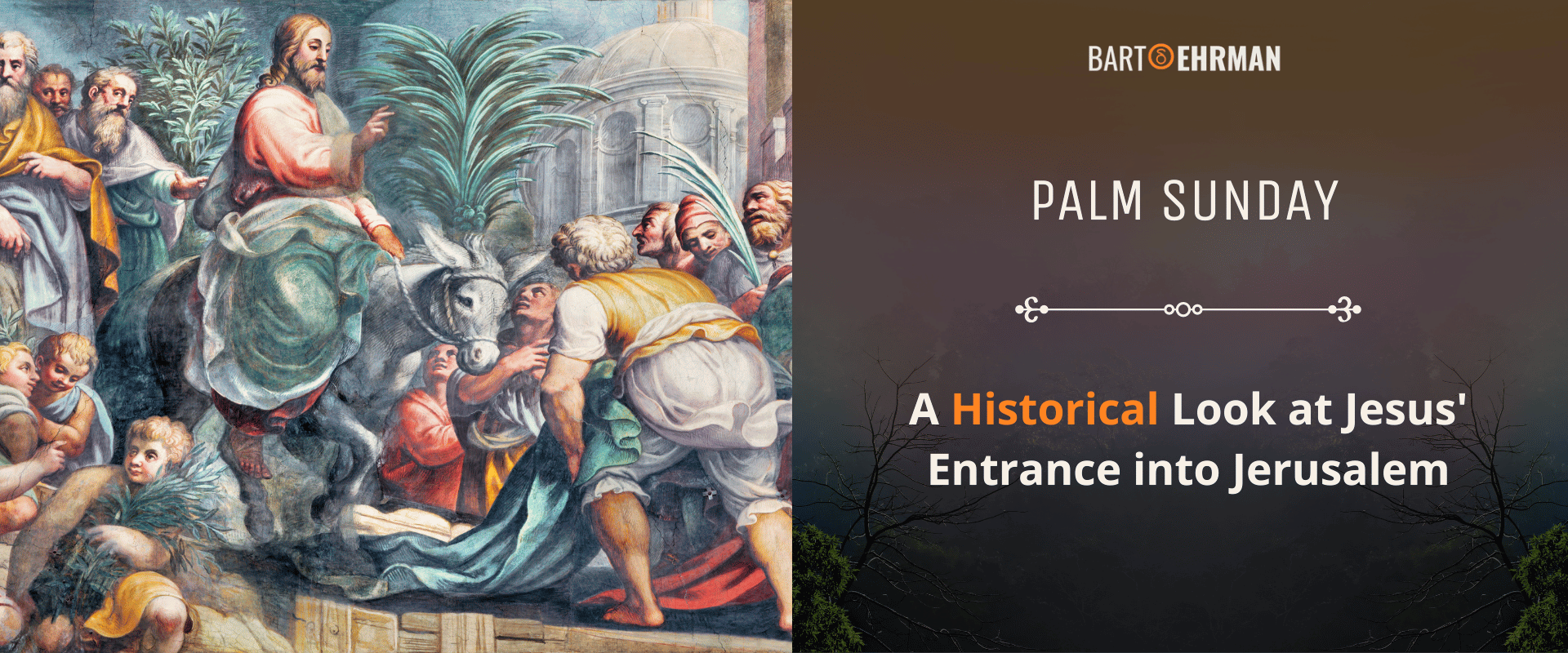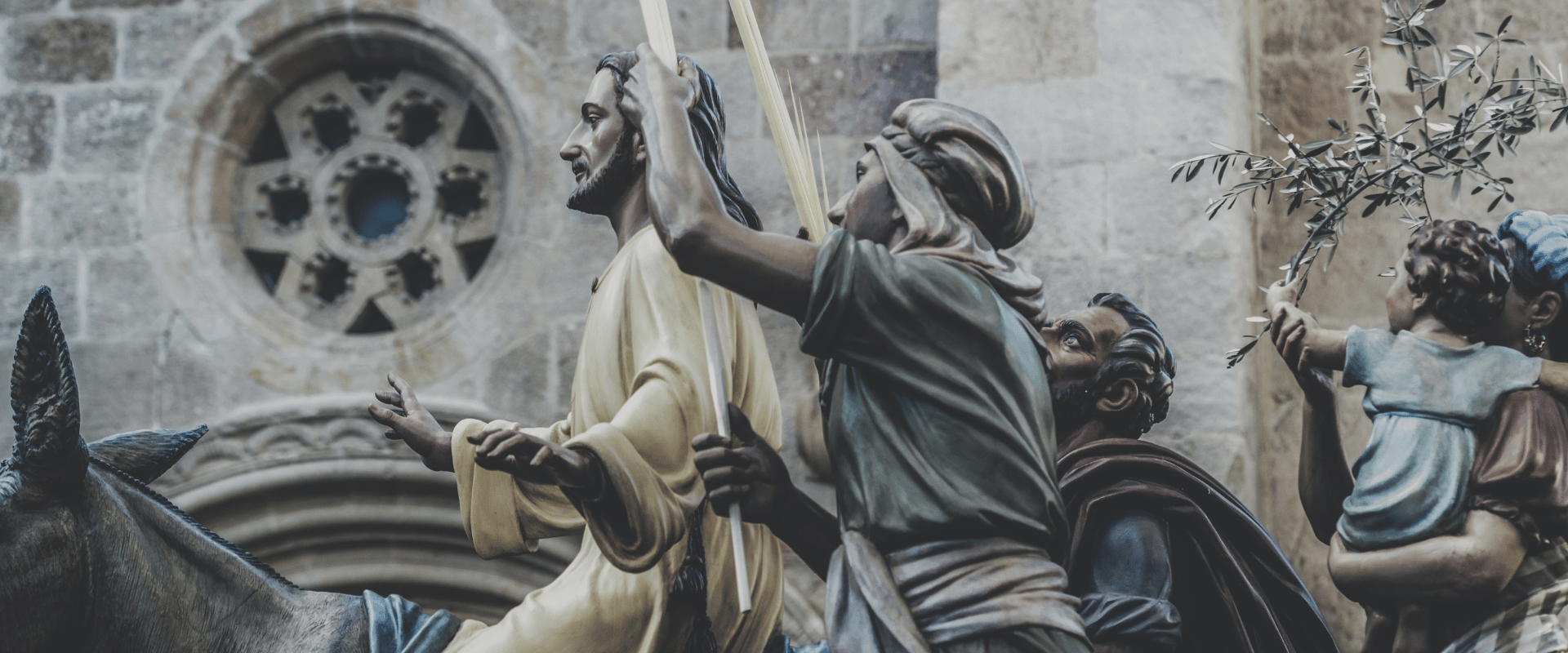Palm Sunday: A Historical Look at Jesus' Entrance Into Jerusalem

Written by Joshua Schachterle, Ph.D
Author | Professor | Scholar
Author | Professor | BE Contributor
Verified! See our editorial guidelines
Verified! See our guidelines
Date written: June 25th, 2024
Disclaimer: The views and opinions expressed in this article belong to the author and do not necessarily match my own. - Dr. Bart D. Ehrman
Palm Sunday commemorates the triumphal entry of Jesus into Jerusalem, a story found in all four canonical Gospels which has immense symbolic connotations. Each Gospel presents a unique perspective, adding layers to the Palm Sunday meaning.
Palm Sunday is important for Christians as the precursor to Jesus’ salvific crucifixion and resurrection. It’s a celebration of Jesus before the tragic events of his arrest, torture, and death.
The triumphal entry is a crucial moment in Jesus' ministry — the culmination of his divine mission — suggesting the profound events to come. In this article, I’ll examine the individual perspectives in Palm Sunday scripture references, explain the story’s historical context, and unpack the symbolism that makes this narrative so significant.

Jesus’ Triumphal Entry in the Gospels
As I said above, Jesus’ dramatic entry into Jerusalem is included in all four of the canonical Gospels. Here is how Mark, our earliest written Gospel, narrates it in 11:1-10:
When they were approaching Jerusalem, at Bethphage and Bethany, near the Mount of Olives, [Jesus] sent two of his disciples and said to them, “Go into the village ahead of you, and immediately as you enter it you will find tied there a colt that has never been ridden; untie it and bring it. If anyone says to you, ‘Why are you doing this?’ just say this: ‘The Lord needs it and will send it back here immediately.’” They went away and found a colt tied near a door, outside in the street. As they were untying it, some of the bystanders said to them, “What are you doing, untying the colt?” They told them what Jesus had said, and they allowed them to take it. Then they brought the colt to Jesus and threw their cloaks on it, and he sat on it. Many people spread their cloaks on the road, and others spread leafy branches that they had cut in the fields. Then those who went ahead and those who followed were shouting,
“Hosanna!
Blessed is the one who comes in the name of the Lord!
Blessed is the coming kingdom of our ancestor David!
Hosanna in the highest heaven!”
In Mark, all the basic elements of the story are there: the approach to Jerusalem from the Mount of Olives, the colt that has never been ridden, cloaks thrown on the colt’s back before Jesus rode it, branches and cloaks spread on the road in front of Jesus, and the people’s jubilant chants. However, as is often the case, each Gospel changes the story just a bit.
Matthew 21:11 contains a slightly different version of the story. In Matthew, the animal situation is… unusual. Matthew views the situation as the fulfillment of a prophecy from Zechariah 9:9, which says:
Rejoice greatly, O daughter Zion!
Shout aloud, O daughter Jerusalem!
See, your king comes to you;
triumphant and victorious is he,
humble and riding on a donkey,
on a colt, the foal of a donkey.
Unfortunately, Matthew reads the prophecy without understanding it completely. As Bart Ehrman notes, Hebrew poetry was often organized conceptually rather than by rhyme scheme. This was the case for the poem from Zechariah, in which the idea in the penultimate line is repeated in the last line with different words.
Because the author of Matthew doesn’t understand this, he interprets the verse as saying that the king will ride both on a donkey and a colt, which is what he has Jesus do. He doesn’t explain the gymnastics one would have to do to straddle two animals this way, but our imaginations can fill in the details.
Matthew also adds a question from someone at the end of the procession: “Who is this?” The crowd answers “This is the prophet Jesus from Nazareth in Galilee.”
Luke’s version in 19:29-40 is similar to Mark’s version, as well as Matthew’s (though without the two animals). However, in both Mark and Luke (but not Matthew), after his triumphal entry, Jesus goes to the Temple and looks around before leaving and going out to Bethany.
This is interesting because in all three Synoptic Gospels, Jesus’ next action will be to cleanse the Temple. His looking around the Temple makes it seem as though he might be planning it, which happens the next day. John —like Matthew —doesn’t include this detail because for him, the Temple cleansing happened at the beginning of Jesus’ ministry.
Also of interest, only John’s version in 12:12-19 says that the branches the crowd picks are from palm trees (Greek: “phoinikon”); the Synoptics simply say leafy branches. Other than that, John’s version is substantially the same as the others, although the author also notes that this happened directly after Jesus had raised Lazarus from the dead — something that doesn’t happen in any of the Synoptics.
FREE COURSE!
WHY I AM NOT A CHRISTIAN
Raw, honest, and enlightening. Bart's story of why he deconverted from the Christian faith.
Over 6,000 enrolled!
What Were Triumphs in the Roman Empire?
Part of the context necessary for understanding the meaning of Jesus’ triumphal entry and thus the church celebration of Palm Sunday relates to Roman Empire politics.
The Roman triumph (Latin: “triumphus”) was part political service and part religious ritual in ancient Rome. It publicly commemorated and blessed the accomplishments of a military commander who had led the Roman army to conquest abroad.
The triumph consisted of a massive parade in which the conquering military hero would ride in a chariot pulled by four horses as the crowd cheered). Also included were the most prominent prisoners of war from the conquered lands (sometimes accompanied by their families) and any treasures plundered from that land. The whole thing was a celebration of war, conquest, and the violent power of Rome.
Often, those who received triumphs went on to impressive political careers and even became emperors. What does this have to do with Jesus’ triumphal entry into Jerusalem? Let’s discuss the symbolic nature of the story.
Symbolism in Jesus’ Triumphal Entry
What is Palm Sunday’s meaning? To understand that, we have to look at how the various versions of Jesus' triumphal entry use symbolism.
The Gospels are not history. That is, they are not just history. They were written as theology within a narrative framework. This doesn’t mean, of course, that there is no history in them. Rather, it means their ultimate purpose was to emphasize Jesus’ significance symbolically through stories. Understanding this symbolism helps you interpret the stories more accurately.
For instance, it’s important that in all four Gospels, Jesus is coming from the Mount of Olives toward his procession in Jerusalem. In Zechariah 14:3-5, God says that when he comes to fight against Israel’s enemies and save them, he will start from the Mount of Olives. In other words, the Mount of Olives signified salvation for Israel.
Furthermore, in their book The Last Week: What the Gospels Really Teach About Jesus's Final Days in Jerusalem, John Dominic Crossan and Marcus Borg write “What we often call the triumphal entry was actually an anti-imperial, anti-triumphal one, a deliberate lampoon of the conquering emperor entering a city on horseback through gates opened in abject submission."
This means that everything that happens in Jesus’ version of a triumph is diametrically opposed to the Roman triumph. For example, he rides neither in an imperial chariot nor on a horse, the beast of burden most associated with war in the ancient Mediterranean. Instead, he purposely uses a donkey.
In Matthew 19-28: Volume 3 (International Critical Commentary), William Davies and Dale Alison write that while a king would ride (or be pulled by) a horse when going to war, he would ride a donkey to symbolize a peaceful arrival to a foreign city. Additionally, in the Jewish Annotated New Testament, Lawrence Wills notes that the coronation of a king also included riding a colt (see Genesis 49:11). Whether or not Jesus’ triumphal entry is an historical event, the Gospel writers would have been well aware of this symbolism.
In addition, the tradition of covering the path of a person worthy of honor is found in the Hebrew Bible. For example, in 2 Kings 9:13, when a man named Jehu is anointed king of Israel, his supporters spread their cloaks on his path, shouting “Jehu is king!”
Finally, why is it important that the branches the people wave and/or lay on Jesus’ path be from palms (again, only specified in John)? First, in Jewish tradition, the palm was one of the four species carried in ceremonies for the pilgrimage festival of Sukkot, as mandated in Leviticus 23:40.
However, for Romans, palm branches symbolized something entirely different. In his book Martial Book VII, A Commentary, Guillermo Galán Vioque writes that in Greco-Roman culture, palm branches were the symbol for the goddesses Nike (Greek) and Victoria (Latin). During Roman triumphs, the conquering hero would be adorned with palm branches as a symbol of his various victories.
Given this Jewish and Roman symbolism, John’s specification of palm branches may mean the author saw Jesus as a Jewish conqueror over sin, perhaps, or death, or even Rome’s traditional power. Remember that Matthew directly references the prophecy in Zechariah 9:9, in which a king is said to be “triumphant and victorious,” although also humble, symbolized by his riding a donkey.
This is why the Palm Sunday meaning is so significant. The important church holiday celebrates both Christ’s victory and the beginning of his arduous journey toward the cross.

The Adoration of the Crowds
As I said before, it’s impossible to know whether this triumphal entry, which opposed Rome’s concept of a triumph happened the way it is narrated in the Gospels. However, there is significance in the story beyond the physical symbols of the donkey, the covering of the path, and the palm branches.
The crowds shout out to Jesus, as celebrating people often do during parades. However, what they say also matters. To remind you, in Mark they shouted:
“Hosanna!
Blessed is the one who comes in the name of the Lord!
Blessed is the coming kingdom of our ancestor David!
Hosanna in the highest heaven!”
What does hosanna mean? Well, it’s a Hebrew word, “hôšîʿâ-nā”, which means “save, rescue, or savior.” For some context, it is used in the Hebrew Bible, especially the Psalms. Psalm 118:25 says “Save us (Hosanna), we beseech you, O Lord!” So in one sense, the crowd is asking Jesus to save them. In another parallel sense, it’s calling him “savior.” To this day, churches celebrate Palm Sunday with liturgies that use the word hosanna.
The next thing they chant – “Blessed is the one who comes in the name of the Lord!” – is also from Psalm 118, this time verse 26. So the Gospel writers are clearly calling readers’ attention to Jesus as a fulfillment of the prophecy in the Psalm.
There are differences in the crowd chants, likely because of each Gospel’s emphasis. For Mark, Jesus is the Messiah and, therefore, must come from the family of David. Matthew leaves this reference to David’s line out, as does Luke.
Luke has the crowds say “Blessed is the King who comes in the name of the Lord! Peace in heaven and glory in the highest!” This accords both with Jesus as king, which John also says, and with what the angels proclaim to the shepherds when they announce Jesus’ birth: “Glory to God in the highest heaven, and peace on earth to those with whom he is pleased!”
Conclusion
Palm Sunday is an important holiday for every Christian denomination because Jesus’ triumphal entry into Jerusalem is one of the best-known stories in the Gospels, shared by all four, although there are differences. The story of Palm Sunday in Scripture is rife with symbolism that can only be decoded if we know the historical context in which it was written.
The procession of Jesus into the city was meant to mimic a Roman triumph, a celebratory parade that honored a conquering military honored for his violent accomplishments. Knowing this, we can see how the story of Jesus’ “triumph” subverts the traditional elements of a Roman triumph while encompassing ancient Jewish symbolism.
For instance, Jesus, rather than riding a horse which symbolized war, sits on a donkey, which symbolizes humility and peace. Nevertheless, the people lay down their cloaks on Jesus’ path, a common Hebrew gesture meant to honor a new king.
The people also lay down or wave palm branches, which, for Romans, symbolized victory. Jesus’ victory, however, would be non-violent, in stark contrast to the Romans who controlled Palestine in his time. For the Gospel authors, he may have been a conqueror, but was believed ultimately to conquer sin and death to save people, rather than destroying them.
Finally, the crowds who welcome Jesus in the story shout the word “hosanna”, a Hebrew word meaning both “save” and “savior.” A 1st-century Jewish reader of this story would no doubt have been aware of how this word was used in the Hebrew Bible, tying Jesus to prophecy. They would also have known that according to its meaning, the story was claiming Jesus as savior.
FREE COURSE!
WHY I AM NOT A CHRISTIAN
Raw, honest, and enlightening. Bart's story of why he deconverted from the Christian faith.
Over 6,000 enrolled!
